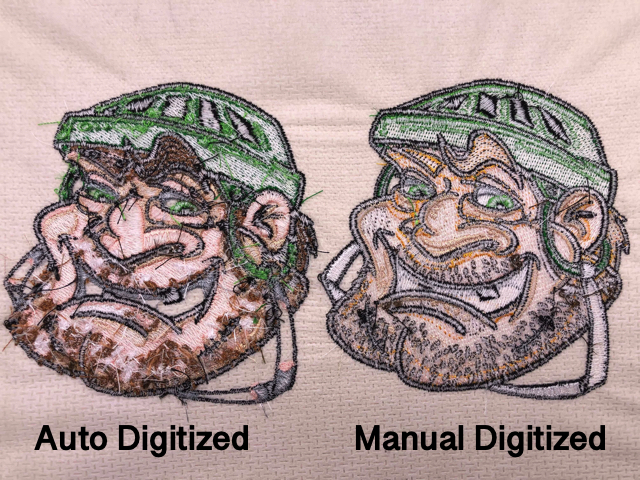Expert Digitizing for Embroidery: High-Quality Designs
Expert Digitizing for Embroidery: High-Quality Designs
Blog Article
Understanding the Embroidery Digitizing Process: Your Ultimate Overview
Needlework digitizing is a thorough craft that requires precision and expertise to convert intricate styles into digital formats for device embroidery. As craftsmens begin on this trip to understand the needlework digitizing procedure, a thorough understanding of the essentials establishes the foundation for quality.

Understanding Embroidery Digitizing Basics
Embroidery digitizing basics form the foundation whereupon intricate styles are converted right into machine-readable layouts for specific sewing. This preliminary action in the needlework digitizing process is important for making sure that the final embroidered item is a loyal representation of the initial layout. Recognizing needlework digitizing fundamentals includes understanding key concepts such as stitch kinds, sew direction, density, underlay, and pull settlement.
Stitch types play a vital duty in establishing the aesthetic and textural end result of the embroidered style. By choosing the proper stitch type, whether it be satin, fill, or running stitch, digitizers can achieve the desired effect and improve the general high quality of the needlework. Furthermore, stitch instructions affects the flow and measurement of the design, while thickness establishes the spacing and insurance coverage of the stitches.
In addition, rug stitching gives security to the style by securing the fabric and protecting against distortion throughout the embroidery procedure. Draw compensation is an additional necessary consideration to counteract the all-natural tendency of material to contract when sewn. Grasping these embroidery digitizing basics is basic for producing professional-quality embroidered products.
Choosing the Right Digitizing Software Program
Selecting the proper digitizing software application is a critical decision that dramatically influences the efficiency and high quality of the needlework digitizing procedure. Digitizing for Embroidery. When picking the right digitizing software, it is vital to consider factors such as the complexity of layouts you intend to produce, the user-friendliness of the software, the level of client assistance provided, and the compatibility with your needlework machine
There are different digitizing software application choices offered on the market, varying from standard programs for newbies to innovative software program for specialist digitizers. Some preferred selections consist of Wilcom EmbroideryStudio, Hatch Embroidery Software Application, and PulseID. These software application packages provide a broad range of tools and attributes to aid you develop complex styles with simplicity.
Before deciding, it is advisable to discover the various software application choices with totally free trials or trials to figure out which one finest suits your demands. In addition, checking out reviews and looking for referrals from knowledgeable digitizers can offer valuable insights right into the staminas and weaknesses of each software (Digitizing for Embroidery). By meticulously examining your requirements and contrasting the functions of different digitizing software program, you can make an educated option that enhances your needlework digitizing Related Site process
Digitizing Devices and Methods

Optimizing Layout Setup for Needlework
Grasping the details of style settings is fundamental in attaining optimum results in the embroidery digitizing procedure, structure upon the foundation laid by understanding digitizing devices and strategies. When optimizing design setups for needlework, it is essential to think about elements such as stitch kind, thickness, rug, pull payment, and enrollment. Registration settings straighten different aspects of the design accurately, keeping total layout honesty.

Troubleshooting Common Digitizing Issues
When experiencing common digitizing issues throughout the needlework process, it is vital to comprehend the source and execute efficient solutions promptly. One common problem is stitch density issues, where stitches may be also thick, creating the fabric to pucker, or as well sparse, causing spaces in the design. Readjusting the stitch density setups in the digitizing software can assist settle this issue.
Another constant obstacle is string breaks throughout the needlework process. This can happen due to numerous reasons such as incorrect tension settings, boring review needles, or utilizing low-quality thread. Ensuring proper maintenance of the needlework device, including regular needle changes and tension changes, can minimize the occurrence of string breaks.
In addition, style enrollment errors can result in misaligned components within the needlework style. Checking the style placement in the digitizing software and making necessary modifications prior to sewing can help in preventing this issue. By addressing these common digitizing concerns promptly and effectively, you can make sure a smoother needlework process and top notch completed items.
Final Thought
To conclude, understanding the embroidery digitizing process calls for look at more info a solid understanding of the fundamentals, the right choice of software, and knowledge of devices and methods. Enhancing layout settings and troubleshooting usual digitizing issues are crucial action in guaranteeing top quality needlework outcomes. By complying with these actions vigilantly, one can achieve precision and effectiveness in the digitizing procedure.
Report this page